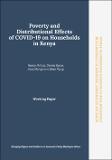Working Paper on Poverty and Distributional Effects of COVID-19 on Households in Kenya
View/
Publication Date
2020Author
Type
KIPPRA Publicationsviews
downloads
Metadata
Show full item recordBy
Nafula Nancy ; Kyalo Dennis ; Munga, Boaz & Ngugi, Rose
Abstract/
The economic and social costs of COVID-19 pandemic have been felt across the globe. With new infections on the rise, it is a race against time for governments to re-look at some policy interventions necessary to provide appropriate coping and recovery mechanisms to respond to the crisis. Informed by the most recent Kenya Integrated Household Budget Survey (KIHBS) 2015/16 data and assumptions on the possible effects of the pandemic on the income of individuals, this paper provides estimates of the poverty impact and simulations of the fiscal costs of mitigating the effects in Kenya. The analysis is informed by microsimulations and Foster, Greer and Thorbecke indices to analyze the effects of the pandemic on poverty. This study estimates that national absolute poverty in Kenya may have declined by 7.2 percentage points from 36.1% in 2015/16 to 28.9% in 2019 (pre-COVID). However, as a result of the pandemic, absolute poverty has increased to 41.9% in 2020, effectively wiping out progress made since 2015/16. This is because households have lost incomes from both labour and non-labour sources amounting to 11.7% of Gross Domestic Product (GDP) or equivalent of Ksh 49.1 billion relative to estimated pre-COVID economic situation. Nationally, about 37.7% of the population (18.0 million people) experienced a loss of their labour and non-labour incomes. The key drivers of the decline in incomes are loss in employment and reduction in earnings majorly due to reduction in labour productivity and trade returns due to the April-June lockdowns.
Subject/
COVID-19 Pandemic; Poverty Impact; Non-labour Sources; Labour Sources; Cash Transfers
Publisher
The African Economic Research ConsortiumSeries
working Paper;2020Collections
- Working Papers [34]

